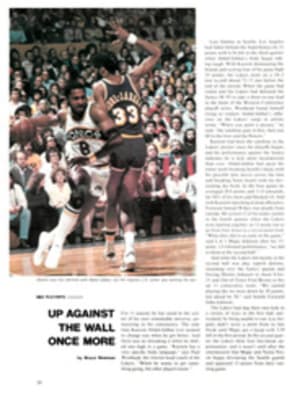
It's a great leap forward
The inscrutable East met the scrutable West last weekend in, of all places, Columbus, Ohio, when the best divers from the People's Republic of China arrived for a dual meet with their U.S. counterparts. Rumors about the Chinese diving team had been circulating since last August, when Dr. Sammy Lee, the U.S. gold medalist in 10-meter platform at the 1948 and 1952 Olympics, returned from a four-week trip to the People's Republic. "When I mentioned to the coaches here how good the Chinese divers I'd seen were, I was told I'd been brainwashed," says Lee. "I said, 'Just wait and see.' " Then last September at the World University Games in Mexico City, American coaches came, saw and were convinced. At least one Chinese diver finished among the top six men and women in both the three-meter springboard and platform, and 5'2", 97-pound Chen Xiaoxia won the women's platform. After Mexico City, Dr. Aaron Weinstein, president of U.S. Diving, the national organization for the sport, called Lee on the telephone to berate him. "You lied to me," he said. "You told me they were good. They're great."
So when the American divers came to Columbus, they were eager to get a close-up look at the Chinese. After watching the visitors practice on Tuesday morning at Ohio State's Peppe Aquatic Center, the Americans were impressed, but not overwhelmed. The Buckeyes' diving coach, Vince Panzano, spelled it out. "I'd say the Chinese women tower divers are better. They're doing harder dives, and they do them better than our girls do theirs. We're about even with their women on the springboard. Our men are as good as the Chinese in tower and better on the springboard."
The Chinese, meanwhile, were being perfect guests, humbly assuring their hosts that they were here to learn. "At this particular meet we want to do very well, and we expect to learn a lot," said the ever-smiling, unfailingly polite Chinese coach, Liang Boxi. "We know that the Americans are great. All their basic moves are excellent, very smooth and well executed. As for us, we have problems. We hope that through exchanges with the American coaches and by watching the U.S. divers work out, we can overcome some of our problems, especially on required dives. The American springboard divers—their moves are so good, they look like they were stamped out of molds."
The Chinese have had little time to be molded into champions. An entire generation of their athletes is missing, thanks to the Cultural Revolution (1966-69) and the so-called Gang of Four. During that period the Chinese Swimming Association, which had been formed in 1952, was disbanded because, according to the Gang of Four, sports competition was capitalistic, individualistic and, therefore, bad. Chinese divers and coaches were sent to the rice paddies to learn the real meaning of work. But by the end of 1976 Mao had died, the Gang of Four had been arrested, and China had begun to rebuild its athletic programs. As a result, the five men and five women sent to Columbus were very young, ranging in age from 16 to 22, and none had been diving for more than six years. This impressed the American coaches. "It takes at least 10 years to make a really good diver," says Panzano. "There are exceptions, like Greg Louganis, who was an Olympic silver medalist at 16, and our current indoor platform champion, Bruce Kimball, who's also 16. They're exceptions. And Bruce started diving at the age of four with the best instruction in the world. His father, Dick, is our national diving coach."
In the years since competitive sports returned to the list of approved activities, the Chinese have been busy playing catch-up, poring over films of American divers and studying U.S. coaching techniques. When Dick Kimball was introduced to Liang, Liang greeted him warmly and said, "The name Kimball is very well known in China. I've always wanted to come here and meet you." Kimball, needless to say, had never heard of Liang.
Besides inexperience in international competition, Chinese divers have a physical peculiarity to contend with. During his visit to the People's Republic, Lee, an otologist, found out that the Chinese have a genetic tendency toward detached retinas, a condition that can be aggravated by impact with the water while diving. "They asked me how many U.S. divers went blind," he says. "It shocked me. I told them I'd never heard of an American going blind from diving." Lee urged the Chinese to consult a well-known Shanghai ophthalmologist, who confirmed the fact that, like myopia, easily detached retinas are characteristic of the Chinese. One diver at Columbus, Li Kongzheng, had suffered two detached retinas, both of which were said to have been successfully repaired with laser-beam surgery. Kongzheng used to be a platform diver, but he switched to the springboard after his condition was discovered.
It was evident from the intensity of their two-a-day practices that the Chinese were determined not to lose face before the tough U.S. team. And the Americans were very strong. Their women's team included Carrie Irish Finneran, the national indoor three-meter springboard champion; Christine Loock, the national indoor platform titleholder; Barbara Weinstein, last year's indoor platform champ and 1979 Pan Am gold medalist; Kit Salness, the '79 outdoor tower titlist; and 17-year-old Megan Neyer, who's accomplished at both springboard and platform. The men's team, according to Aaron Weinstein, was comprised of "the top divers in America—minus one." The minus was Louganis, who stayed away because he had to take final exams at the University of Miami. But Bruce Kimball, veterans Dave Burgering and Kent Vosler, along with Kevin Machemer and Randy Ableman, were on hand to defend America's honor.
The Chinese were apparently so impressed by this lineup that while the Americans took it easy as the meet drew near, the visitors practiced rigorously, their coaches sitting at poolside applauding good dives and criticizing bad ones. Dick Kimball soon determined that the Chinese were coming up with few poor dives. "It could really go either way here," Kimball said the day before the competition began. "Don't let them give you that 'we want to learn' bit. They're here to win."
That became evident on Saturday. The Chinese had refused politely any seats on the five-judge panel. They insisted that all the judges be American. The better to coach and study dives, they said; the better to learn. But when the Chinese brought out their divers, it became obvious that they could teach as well as learn. In the men's platform, one of the two opening-day events, the meet's first 10 (the highest possible score) was awarded to Bruce Kimball, who on the last of his four required dives executed a flawless forward 1½ with a twist. The Chinese oohed and applauded along with everyone else. But in international competition, it's the six optional dives that really turn heads because of their greater degree of difficulty, and the first optional 10 went to Li Hongping, a 17-year-old student from Canton. Hongping launched himself into a back 2½ somersault in a pike position and ripped—made the sound of a bedsheet being torn that is heard when a diver executes a perfect, splashless entry. Hongping ripped every one of his optionals. His third, a reverse 2½ tuck, earned three 10s from the five judges, and his front 3½ pike brought in three 9.5s and two nines. Kimball fought back with two 10s on his fourth optional, a triple-twisting 1½ that ripped. He followed that with a reverse 2½ tuck that earned him four 9.5s and a nine. When the men's tower competition ended, Hongping was first with 617.60 points and Kimball second, 36.25 points back. Tong Hui, who turned 17 two weeks ago but looks more like 12, finished fourth, behind Vosler.
The women's three-meter springboard produced some surprises when Chen Xiaoxia, the 18-year-old Cantonese who had dazzled the crowds in Mexico, beat Neyer by 8.40 points. Megan might have taken the title had she not blown an inward 2½ tuck. Shi Meiqin finished third.
By Saturday night the Chinese team led the U.S. 23-21, but Coach Kimball was philosophic. "We did a very fine job," he said. "It would have been better with Louganis, but in all honesty, the Chinese are world-class divers. There's no shame in losing to them. And we're not out of it yet."
But on Sunday, they were. The final score: China 45, U.S. 43. The Chinese dominated the women's platform event, taking first, second and fourth, but the Americans came back in the men's springboard, which Burgering won, with Machemer second and Kimball fourth.
"Well, we really didn't know what to expect," said Panzano as the crowd drifted out of the Aquatic Center. "Now we know the Chinese team is excellent. And they're great people, friendly and warm."
Fast learners, too.
PHOTO
Tong Hui, who's just 17, gets set to let 'er rip.
PHOTO
Chen Xiaoxia, a wow in Mexico City and Ohio.

